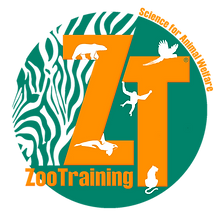top of page

Key projects
Evidence-based training for animal welfare, research, innovation, and your reputation.
Whatever the species.
Parrots
Reinventing the Daily Life of Psittacines in a Zoo.

Action :
Over an 18-month period, a protocol based on positive operant conditioning was implemented with several psittacine species, primarily macaws. A combination of targeted enrichment (nutritional, sensory, cognitive, social) and individualized training sessions led to a significant reduction in stereotypic behaviors and a noticeable improvement in feather condition. The development of structured free flight, voluntary medical training, and redesigned presentations enhanced educational value while enabling a more authentic transmission of passion to the public.
Observed Impact :
Tangible progress in animal welfare, supported by improved behavioral indicators and a more meaningful connection between birds and visitors.
Giant otters
Enhancing Cooperation and Autonomy Within a Group of Giant Otters

Action :
Over a 4-month period, targeted support was provided to the lead keeper of a group of four giant otters (a breeding pair and their offspring) to integrate the fundamentals of operant conditioning into daily practice. The goal was to improve control over group movements (external recalls, shifting, stress-free separations, stationing), while strengthening the bond between keeper and animals. A skills transfer process was also initiated to spread these best practices throughout the team.
Observed Impact :
Smooth daily cooperation (shifting, weighing, recalls) managed by a single keeper, and an enhanced public presentation thanks to closer proximity and improved visibility of the otters at their enclosure’s viewing window.
Polar bears
Stereotypy, cooperation and visibility: A behavioral Turning Point.

Action :
Over a 6-month period, a structured support program was implemented for four polar bears (2 males, 2 females) to establish the foundations of ethical and sustainable cooperative work. Objectives included reducing repetitive behaviors such as stereotypy, rebuilding confidence in their environment and around door transitions, enriching their daily routine, and introducing key medical behaviors (stationing, targeting, gating, voluntary blood draw). The approach relied on prior behavioral observation, smooth team communication, and optimized keeper routines.
Observed Impact :
A 70% reduction in stereotypic behaviors, more active and visible animals, a strengthened team dynamic, and a more engaging visitor-animal experience.
More projects explained soon
Our experience is enriched by projects involving many different species and individuals. Very soon, we’ll be updating this section with more challenges we’ve taken on.

Soon...
Tigers
From Aggression to Cooperation: A Training Program for Two Tigers

Action :
Over a 6-month period, a behavioral rehabilitation protocol was implemented for a pair of tigers recently transferred as part of an EAZA breeding program. Upon arrival, both individuals showed a high level of aggression. Through a gradual approach combining controlled negative reinforcement and positive operant conditioning, in close collaboration with the veterinary team, the animals regained calm and stability. The work also helped prevent stereotypic behaviors, develop the first husbandry behaviors (shifting, weighing, targeting), and train the staff in a more ethical and cooperative approach to animal training.
Observed Impact :
The tigers are now calm, confident, and fully cooperative. The staff has been sensitized to the principles of respectful and safe training, culminating in the park’s first-ever cooperative weighing of tigers.
Walruses
Research and Conservation: An International Study on Walruses

Action :
As part of an international scientific project led by Dr. Karyn D. Rode (USGS), a year-long collaboration was carried out to train a group of six walruses to actively and voluntarily participate in a body condition monitoring protocol using photogrammetry. This required an in-depth understanding of the study’s scientific needs, the development of a training program based on operant conditioning, and close coordination between behavioral, veterinary, and scientific teams at an international level.
Observed Impact :
The cooperative behaviors achieved enabled successful protocol validation and the publication of the scientific article in Marine Ecology Progress Series. The method now contributes directly to conservation efforts for wild walrus populations. The project also helped strengthen the park’s reputation for ethical and innovative research on marine mammals.
🔗 Read the study
Belugas
Science, Europe’s first beluga calf and animal training innovation.

Action :
Over two years, a multidisciplinary team (behavioral, veterinary, scientific) ensured the successful gestation and birth of Kyla, the first beluga calf born and raised in Europe. We implemented an innovative and rigorous scientific protocol incorporating the educational tool “baby Sd,” which enabled the mother to bring her calf to the caregivers for ethical care and nursing — this protocol won the Best Learning Presentation award at EAAM in 2016. The project also involved targeted communication and cutting-edge collaboration including the Vancouver Aquarium.
Observed Impact :
The calf is in excellent health, with precise daily monitoring including electrocardiogram and cooperative care. The caregiving team is now trained in advanced and respectful learning methods. Research linked to Audra Ames and Valeria Vergara led to a major publication on beluga vocal repertoire development (Trajectories of Vocal Repertoire Development in Beluga – Aquatic Mammals) (🔗Read the study).
Furthermore, advances in respiratory physiology under the leadership of Andreas Fahlman have enhanced understanding of cetacean metabolism (🔗Read the study).
This success has cemented the park’s reputation as a center of excellence for ethical and innovative marine research.
bottom of page